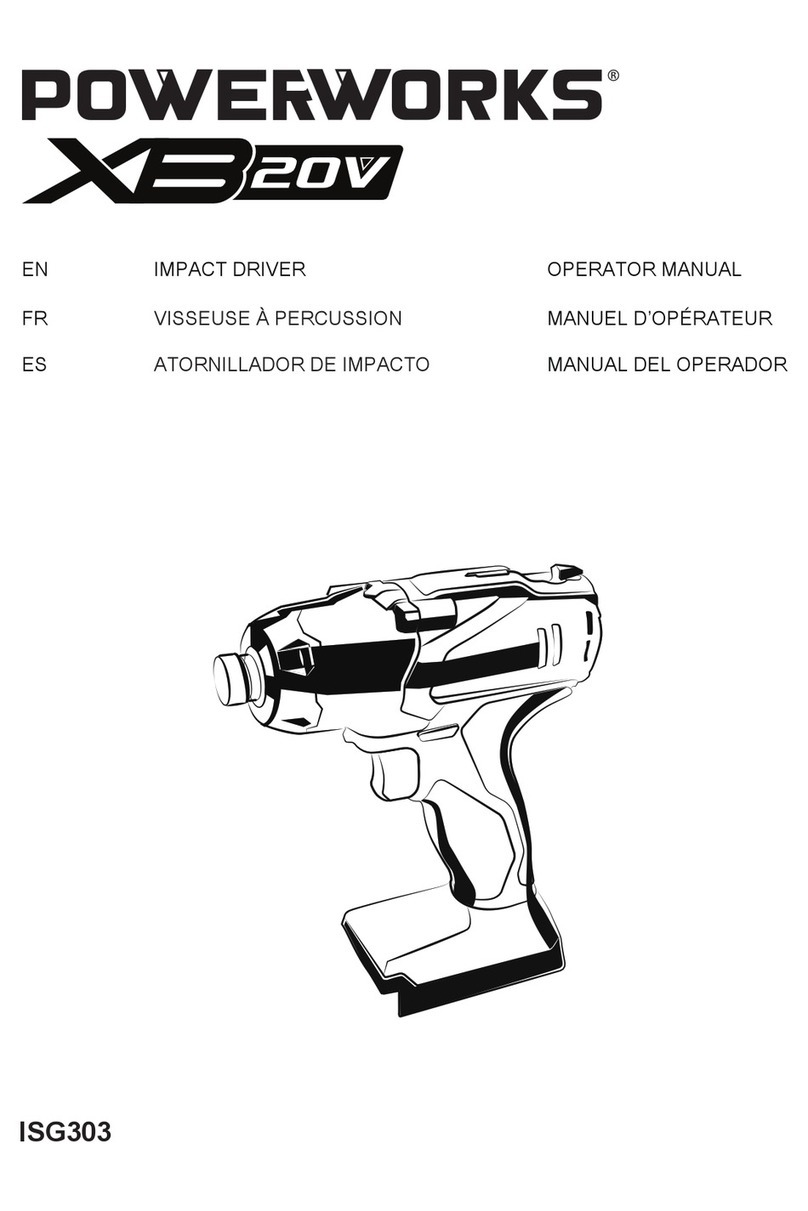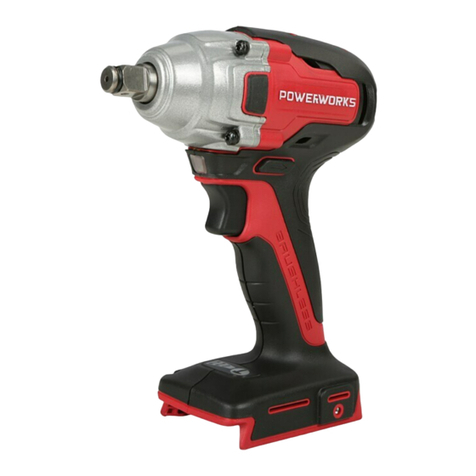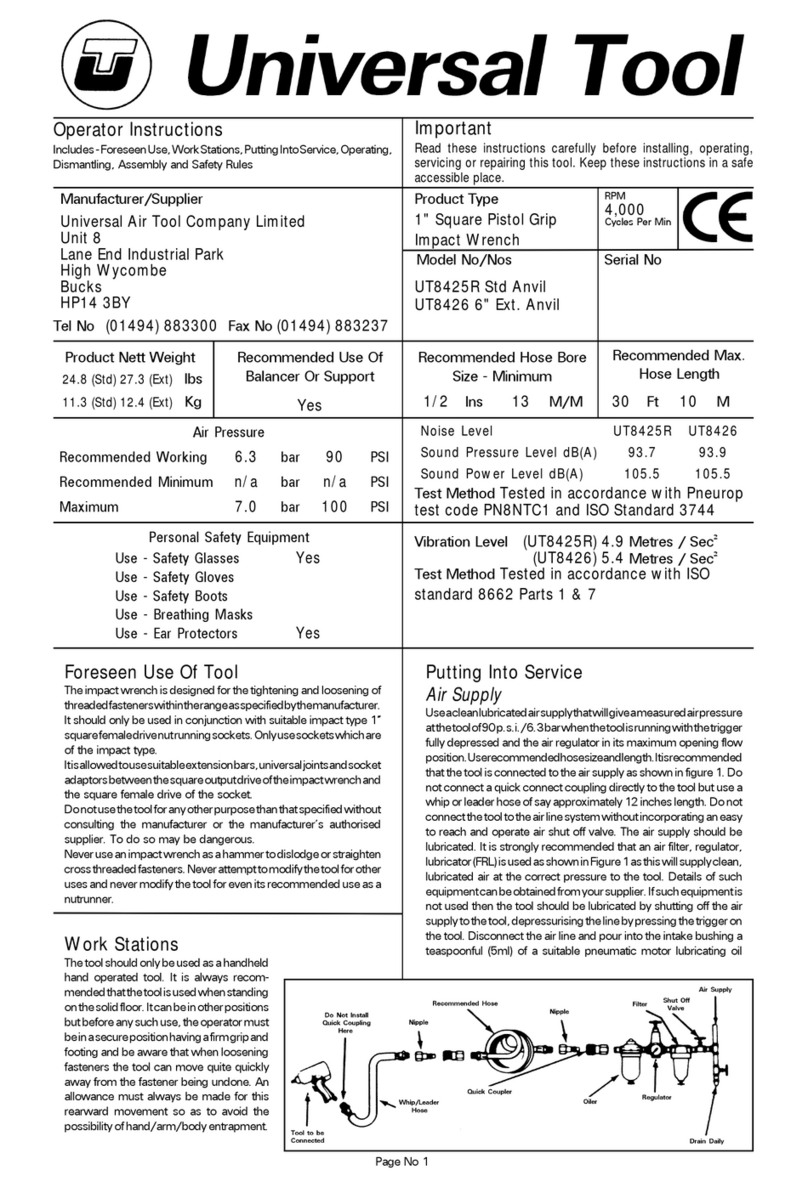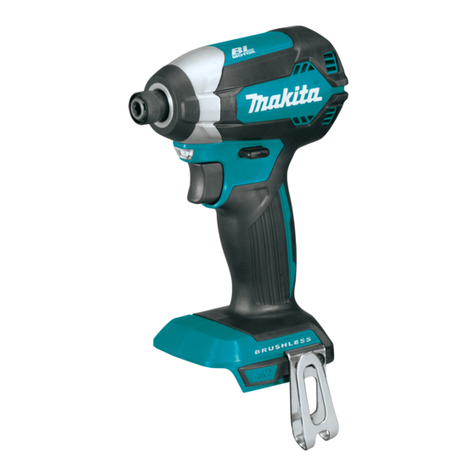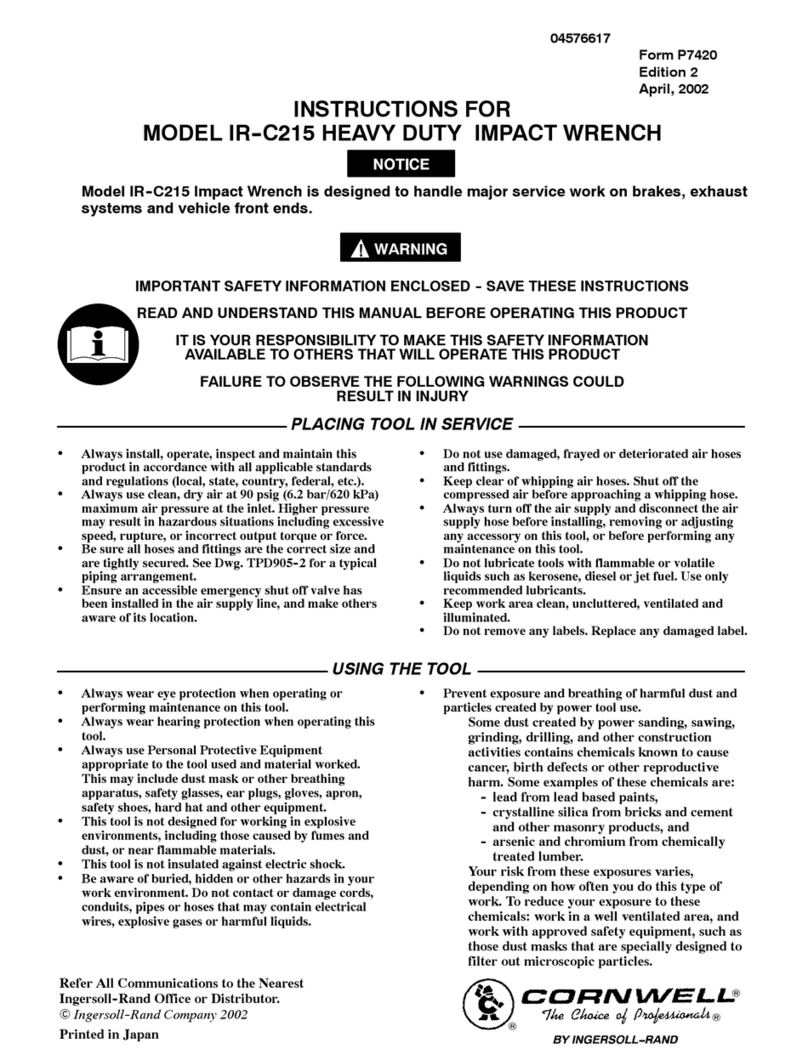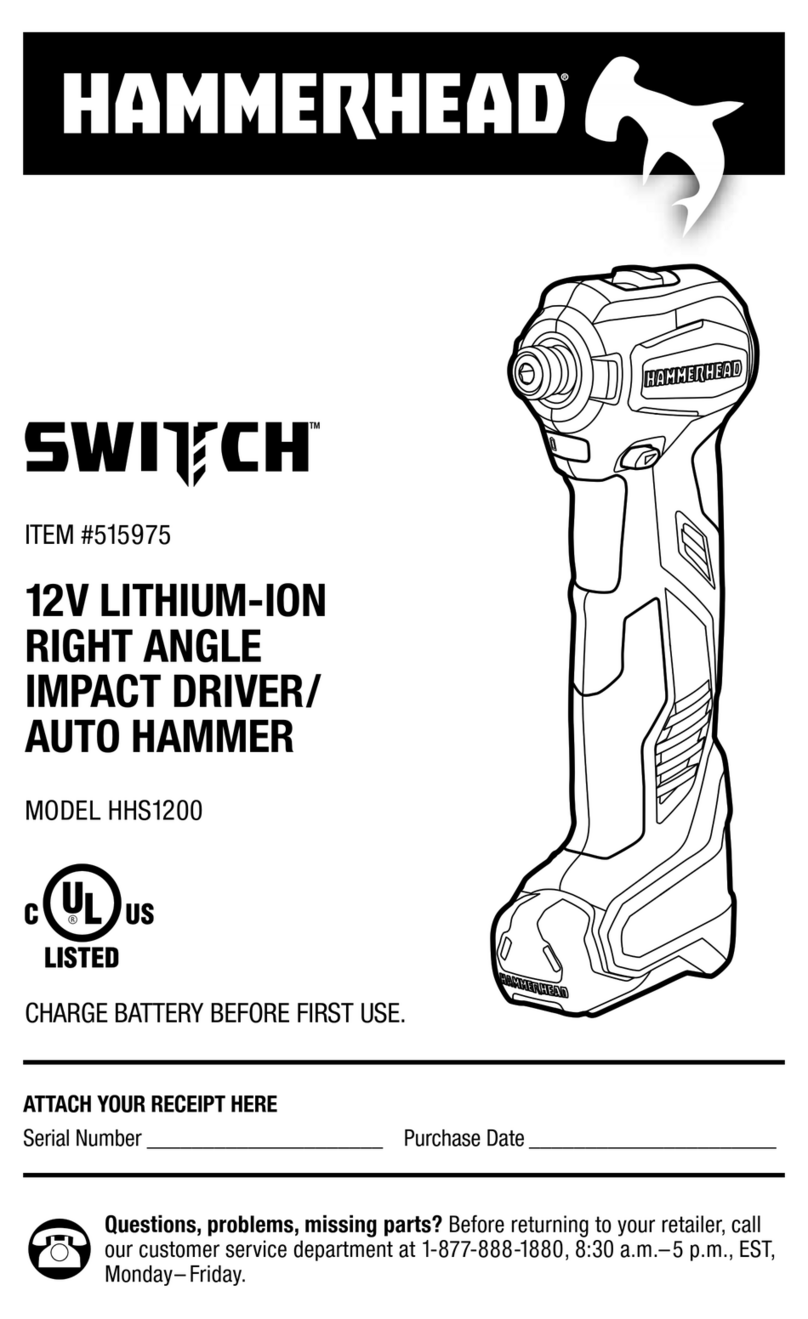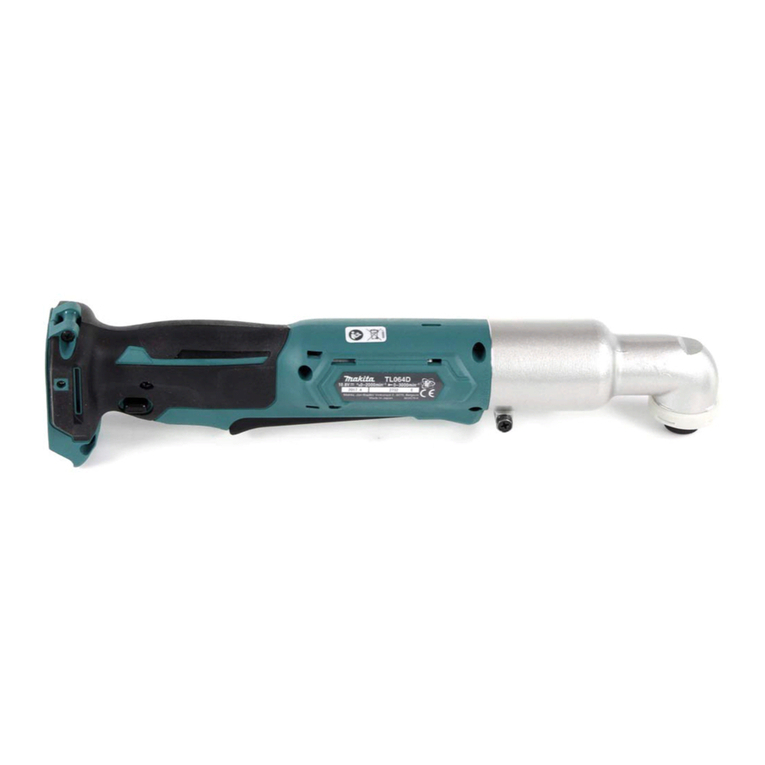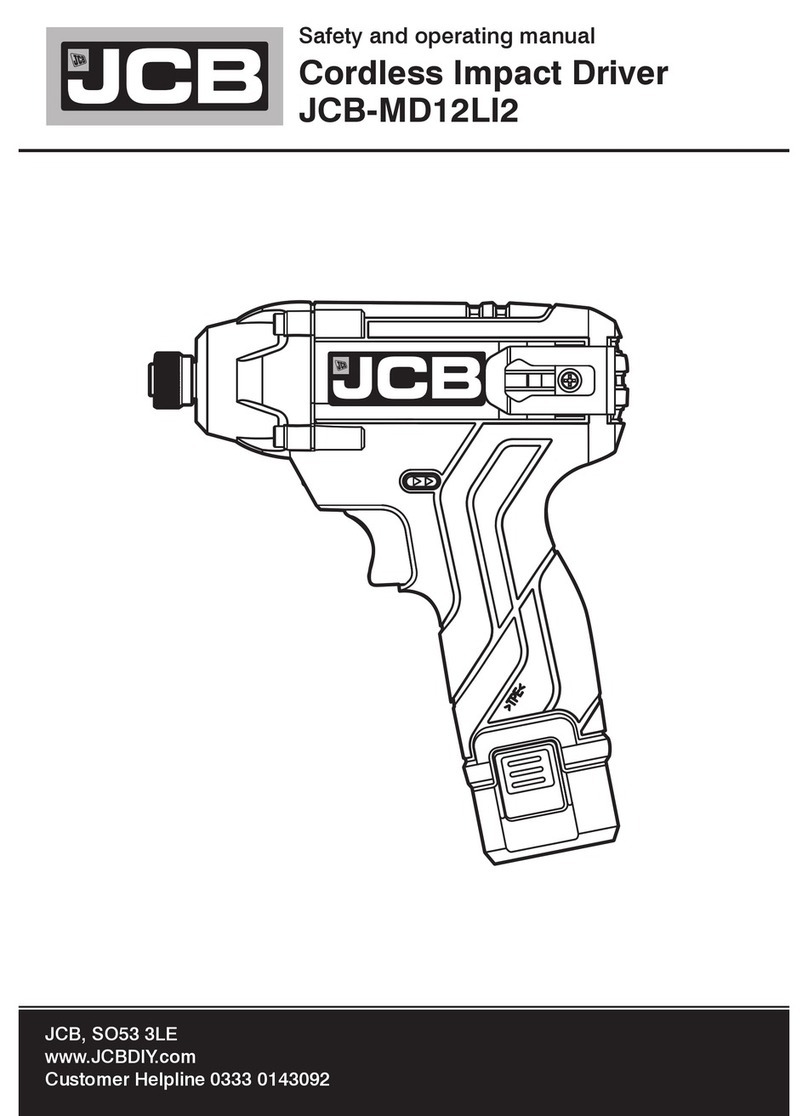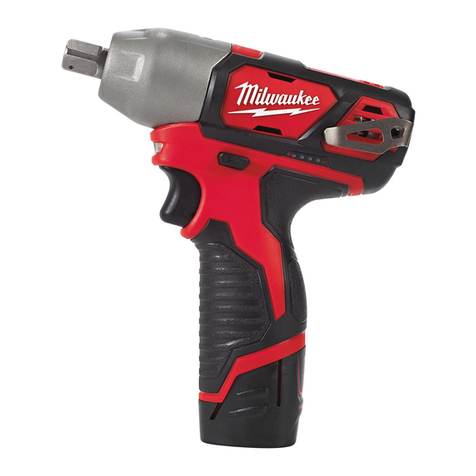Power works PD24D90 User manual

DDM406
OPERATOR MANUAL / BEDIENUNGSHANDBUCH / MANUAL DEL OPERARIO /
MANUALE DELL’OPERATORE / MANUEL OPÉRATEUR / MANUAL DE UTILIZAÇÃO /
GEBRUIKSAANWIJZING / РУКОВОДСТВО ОПЕРАТОРА / KÄYTTÖOPAS /
ANVÄNDARHANDBOK / BRUKERVEILEDNING / BRUGSVEJLEDNING / INSTRUKCJA
UŻYTKOWNIKA / NÁVOD K OBSLUZE / NÁVOD NA OBSLUHU / Uporabniški priročnik /
PRIRUČNIK ZA RUKOVANJE / HASZNÁLATI ÚTMUTATÓ / MANUAL DE UTILIZARE /
РЪКОВОДСТВО НА ОПЕРАТОРА / ΕΓΧΕΙΡΙΔΙΟ ΧΡΗΣΗΣ / / KULLANIM
KILAVUZU / / OPERATORIAU VADOVAS / LIETOTĀJA ROKASGRĀMATA /
KASUTUSJUHEND
OriginalInstructions / ÜbersetzungderOriginalanweisungen/ Traduccióndelasinstruccionesoriginales/ Traduzionedelleistruzionioriginali/ Traductiondes
instructionsd'origine/ Traduzidoapartirdasinstruçõesoriginais/ Vertalingvandeoriginelegebruiksaanwijzing/ Переводоригинальныхинструкций/
Alkuperäistenohjeidenkäännös/ Översättningavoriginalinstruktionerna/ Produsentensinstruksjoner/ Oversættelseafdeoriginalevejledninger/ Tłumaczenie
oryginalnejinstrukcji/ Překladoriginálního návodu/ Prekladoriginálnehonávodu/ Prevodoriginalnihnavodil/ Prijevodizvornihuputa/ Azeredetiutasítás
fordítása/ Traducereainstrucţiunilororiginale/ Преводнаоригиналнитеинструкции/ Αυθεντικέςοδηγίες/ / Orijinal
TalimatlarınTercümesi/ / Originaliųinstrukcijųvertimas/ Instrukcijutulkojumsnooriģinālvalodas/ Originaalkasutusjuhenditõlge
PD24D90


1 2 3
45
678
2
3
4
5
6
7
8
1
1
2

10
11 12
9
1
2

1 Description...................................4
1.1 Intended use...............................................4
1.2 Overview.................................................... 4
2 General power tool safety
warnings.......................................4
3 Installation................................... 4
3.1 Install the belt clip.......................................4
3.2 Attach the auxiliary handle......................... 4
3.3 Install the bit............................................... 4
3.4 Remove the bit........................................... 4
3.5 Install the battery pack............................... 4
3.6 Remove the battery pack........................... 5
4 Operation..................................... 5
4.1 Adjust the torque........................................ 5
4.2 Adjust direction of rotation .........................5
4.3 Adjust the two-speed gear button...............5
4.4 Start the machine....................................... 5
4.5 Stop the machine....................................... 6
4.6 Adjust the variable speed...........................6
4.7 Drill materials..............................................6
5 Maintenance.................................6
5.1 Clean the machine..................................... 6
6 Technical data..............................6
7 Troubleshooting.......................... 7
8 Warranty.......................................7
9 EC Declaration of conformity.....7
3
English (Original Instructions) EN

1 DESCRIPTION
1.1 INTENDED USE
The machine is used to:
• drilling in all types of wood products (lumber,
plywood, paneling, composition board, and hard
board)
• drilling in ceramics, plastics, fiberglass, and
laminates
• drilling in metals
• driving screws into wood and drywall with
screwdriver bits
1.2 OVERVIEW
Figure 1
1Two-speed gear
button ( HI-LO)
2Auxiliary handle
3Torque adjustment
ring
4Keyless chuck
5LED light
6Trigger
7Directon button
8Belt clip
2 GENERAL POWER TOOL
SAFETY WARNINGS
WARNING
Read all safety warnings, instructions, illustrations
and specifications provided with this power tool.
Failure to follow all instructions listed below may result
in electric shock, fire and/or serious injury.
Save all warnings and instructions for future
reference.
The term "power tool" in the warnings refers to your
mains-operated (corded) power tool or battery-operated
(cordless) power tool.
3 INSTALLATION
3.1 INSTALL THE BELT CLIP
Figure 2
NOTE
The belt clip may be installed on either side of the
housing.
1. Align the belt clip with the hole on the machine.
2. Insert and tighten the screw to secure the belt clip.
3.2 ATTACH THE AUXILIARY HANDLE
Figure 3-4
The auxiliary handle may be installed on either side of
the machine.
1. Turn the handle grip counter-clockwise to loosen it.
2. Open the hooks wide enough to fit over the
mounting ribs, behind the mode selection ring.
3. Place the hooks over the mounting ribs, making
sure the hooks are positioned in the slots as shown.
4. Turn the handle grip clockwise to tighten.
CAUTION
Make sure the handle is secure before beginning
operation.
3.3 INSTALL THE BIT
Figure 5-6
1. Push direction button in the center position to lock
the trigger.
2. Turn the chuck counter-clockwise to open.
3. Tilt the machine upwards to keep the bit from falling
out.
4. Put the bit into the opening of the chuck.
5. Make sure that the bit is centered, then turn the
chuck clockwise to tighten.
NOTE
Do not use a wrench to tighten or loosen the chuck
jaws.
WARNING
Put the bit straight into the chuck. Do not put the bit
into the chuck at an angle then tighten.
3.4 REMOVE THE BIT
Figure 7
1. Push direction button in the center position to lock
the trigger.
2. Turn the chuck counter-clockwise to open.
3. Remove the drill bit.
WARNING
Be prepared for binding at bit breakthrough. When
these situations occur, drill has a tendency to grab
and kick opposite to the direction of rotation and
could cause loss of control when breaking through
material. If not prepared, this loss of control can result
in possible serious injury.
3.5 INSTALL THE BATTERY PACK
Figure 8
4
English (Original Instructions)
EN

WARNING
• If the battery pack or charger is damaged, replace
them directly.
• Stop the machine and wait until the motor stops
before you install or remove the battery pack.
• Read, understand, and follow the instructions in
the battery and charger manual.
1. Align the lift ribs on the battery pack with the
grooves in the battery slot.
2. Push the battery pack into the battery slot until the
battery pack locks into place.
3. When you hear a click, the battery pack is installed.
3.6 REMOVE THE BATTERY PACK
Figure 8
1. Push and hold the battery release button.
2. Remove the battery pack from the machine.
4 OPERATION
WARNING
Always wear eye protection.
WARNING
Do not use any attachments or accessories not
recommended by the manufacturer of this product.
4.1 ADJUST THE TORQUE
Figure 9
The proper setting depends on the job and the type of
bit, fastener, and material you will be using. In general,
use greater torque for larger screws. If the torque is too
high, the screws may be damaged or broken.
1. Turn the torque adjustment ring clockwise to
decrease the torque.
2. Turn the torque adjustment ring counter-clockwise to
increase the torque.
NOTE
Torque adjustment is only active under driver mode.
4.2 ADJUST DIRECTION OF
ROTATION
The machine has the direction button (forward/reverse
lock) above the switch trigger to change the direction of
the bit.
Figure 10
1. When the direction button is on the left side of the
switch trigger, the bit direciton is forward.
2. When the direction button is on the right side of the
switch trigger, the bit direction is reversible.
3. Put the direction button in the OFF (center
lock) position to help decrease the possibility of
accidental start when not operating.
WARNING
Release the switch trigger and let the chuck come to a
complete stop to stop the machine.
WARNING
Let the chuck come to a complete stop before
changing the direction of rotation.
NOTE
The machine does not operate until the direction
button is pushed fully to the left or right.
4.3 ADJUST THE TWO-SPEED GEAR
BUTTON
Figure 11
The machine has a two-speed gear train designed for
drilling or driving at LO (1) or HI (2) speeds. A slide
switch is on top of the machine.
1. When you use the machine in the LO (1) speed, the
speed decreases and the machine has more power
and torque.
2. When you use the machine in the HI (2) speed, the
speed increases and the machine has less power
and torque.
WARNING
Use LO (1) speed for high power and torque
applications and HI (2) speed for fast drilling or driving
applications.
4.4 START THE MACHINE
Figure 12
NOTE
The machine can not work until the direction button
is pushed fully to the left or right. Do not operate the
machine at low speeds for extended periods of time.
1. Hold the machine firmly, with one hand on the main
handle and one hand on the auxilliary handle.
2. Push direction button to the left or right.
3. Push the switch trigger to turn the machine ON.
NOTE
This machine is equipped with an electric brake. When
the trigger is released, the electric brake engages
automatically to quickly stop rotation.
5
English (Original Instructions) EN

4.5 STOP THE MACHINE
1. Release the trigger to turn the machine OFF.
WARNING
Release the trigger and allow the machine to come to
a complete stop.
4.6 ADJUST THE VARIABLE SPEED
Figure 12
1. Increase the trigger pressure to make a higher
speed.
2. Decrease the trigger pressure to make a lower
speed.
4.7 DRILL MATERIALS
• When drilling hard, smooth surfaces, use a center
punch to mark the desired hole location. This can
prevent the drill bit from slipping off-center when
drilling is started.
• When drilling metals, use a light oil on the drill bit to
prevent it from overheating. The oil can prolong the
life of the bit and increase the drilling action.
• If the bit jams in the workpiece or if the drill falls,
stop to use the machine immediately. Remove the
bit from the workpiece and analyze the cause of the
jam.
NOTE
This drill has an electric brake. When the switch
trigger is released, the chuck stops turning. When the
brake is functioning properly, sparks can be visible
through the vent slots on the housing. This is normal
and is the action of the brake.
WOOD DRILLING
For maximum performance, use high speed steel bits
for wood drilling.
1. Operate the machine at a very low speed to prevent
the bit from slipping off the starting point. Increase
the speed as the drill bit bites into the material.
2. When drilling through holes, put a piece of
wood behind the workpiece to prevent ragged or
splintered edges on the back side of the hole.
METAL DRILLING
For maximum performance, use high speed steel bits
for metal or steel drilling.
1. Operate the machine at a very low speed to prevent
the bit from slipping off the starting point.
2. Hold consistent speed and pressure to avoid
overheating the bit. Applying too much pressure
can: Overheat the drill; Wear the bearings; Bend or
burn bits; and Produce off-center or irregular-shaped
holes.
3. When drilling large holes in metal, start with a small
bit, then finish with a large bit. Also, lubricate the bit
with oil to improve drilling action and increase the
bit's life-time.
5 MAINTENANCE
CAUTION
Do not let brake fluids, gasoline, petroleum-based
materials touch the plastic parts. Chemicals can
cause damage to the plastic, and make the plastic
unserviceable.
CAUTION
Do not use strong solvents or detergents on the plastic
housing or components.
WARNING
Remove the battery pack from the machine before
maintenance.
5.1 CLEAN THE MACHINE
CAUTION
The machine must be dry. Humidity can cause risks of
electrical shocks.
• Clear the unwanted material out of the air vent with
a vacuum cleaner.
• Do not spray the air vent or put the air vent in
solvents.
• Clean the housing and the plastic components with
a moist and soft cloth.
6 TECHNICAL DATA
Voltage 24 V
No load speed 0-550 / 0-2100 min-1
Chuck 13 mm Keyless
Clutch 21 Positions + Drill
Torque 90 Nm
Weight without battery 1.28 kg
Battery model P2448B4, P2448B6 and
other BAM series
Charger model P2448C and other CAM
series
Measured sound pressure
level
77 dB(A), KpA= 5 dB(A)
Measured sound power
level
85 dB(A), KwA= 5 dB(A)
Vibration < 2.5 m/s2,K = 1.5 m/s2
6
English (Original Instructions)
EN

The recommended ambient temperature range:
Item Temperature
Appliance storage temper-
ature range
32°F (0°C) - 113°F (45°C)
Appliance operation tem-
perature range
32°F (0°C) - 113°F (45°C)
Battery charging tempera-
ture range
39°F (4°C) - 104°F (40°C)
Charger operation temper-
ature range
39°F (4°C) - 104°F (40°C)
Battery storage tempera-
ture range
32°F (0°C) - 113°F (45°C)
Battery discharging tem-
perature range
32°F (0°C) - 113°F (45°C)
7 TROUBLESHOOTING
NOTE
Due to the high-power output of this tool, it is
recommended to use Powerworks 24V battery with
minimum 4Ah capacity or greater (e.g. G24B4). Use of
a smaller capcacity battery (e.g. G24B2) may activate
current protection and cause tool damage.
The LED light illuminates when the trigger is depressed.
LED light functions
Machine status LED light sce-
nario Solution
Normal Solid light (no
flashes)
No action nee-
ded
Low battery 3 flashes Replace or
charge battery
Excessive force 6 flashes Restart machine
Over tempera-
ture
9 flashes Let machine cool
off
8 WARRANTY
(The full warranty terms and conditions can be found on
Powerworks webpage)
The Powerworks warranty is 3 years on the product,
and 2 years on batteries (consumer/private usage)
from the date of purchase. This warranty covers
manufacturing faults. A faulty product under warranty
might be either repaired or replaced. A unit that has
been misused or used in other ways then described
in the owner’s manual might be rejected for warranty.
Normal wear, and wear parts are not considered as
warranty. The original manufacturer warranty is not
affected by any additional warranty offered by a dealer
or retailer.
A faulty product must be returned to the point of
purchase in order to claim for warranty, together with
the proof of purchase (receipt).
9 EC DECLARATION OF
CONFORMITY
Name and address of the manufacturer:
Name: Globe Technologies Europe GmbH
Address: Brunnenweg 17, 64331 Weiterstadt,
Germany
Name and address of the person authorised to compile
the technical file:
Name: Ralf Pankalla
Address: Brunnenweg 17, 64331 Weiterstadt,
Germany
Herewith we declare that the product
Category: Drill Driver
Model: DDM406
Serial number: See product rating label
Year of Construc-
tion:
See product rating label
• is in conformity with the relevant provisions of the
Machinery Directive 2006/42/EC.
• is in conformity with the provisions of the following
other EC-Directives:
• 2011/65/EU & (EU)2015/863
• 2014/30/EU
Furthermore, we declare that the following parts,
clauses of European harmonised standards have been
used:
• EN 62841-1 EN 62841-2-1; EN 55014-1; EN
55014-2; IEC 62321-3-1; IEC 62321-4; IEC
62321-5; IEC 62321-6; IEC 62321-7-1; IEC
62321-7-2; IEC 62321-8
Place, date: Weiterstadt,
07.07.2023
Signature: Ted Qu,
Quality Director
7
English (Original Instructions) EN

1 Beschreibung.............................. 9
1.1 Bestimmungsgemäßer Gebrauch.............. 9
1.2 Übersicht.................................................... 9
2 Allgemeine
Sicherheitshinweise für
Elektrowerkzeuge........................9
3 Montage........................................9
3.1 Gürtelklammer anbringen...........................9
3.2 Befestigen des Zusatzgriffes......................9
3.3 Einsetzen des Bohrers............................... 9
3.4 Entfernen des Bohrers............................... 9
3.5 Akkupack einsetzen................................. 10
3.6 Akkupack entfernen..................................10
4 Bedienung..................................10
4.1 Einstellen des Drehmoments................... 10
4.2 Drehrichtung einstellen ............................10
4.3 Einstellen des Zweiganggetriebes............10
4.4 Maschine starten...................................... 11
4.5 Maschine anhalten....................................11
4.6 Einstellen der variablen
Geschwindigkeit........................................11
4.7 Bohrmaterialien.........................................11
5 Wartung und Instandhaltung....12
5.1 Maschine reinigen.................................... 12
6 Technische Daten......................12
7 Fehlerbehebung........................ 12
8 Garantie......................................12
9 EG-Konformitätserklärung....... 13
8
Deutsch
DE

1 BESCHREIBUNG
1.1 BESTIMMUNGSGEMÄẞER
GEBRAUCH
Die Maschine dient zum Bohren von:
• Verschiedenen Holzprodukten (Schnittholz,
Sperrholz, Paneele, Setzbretter und Hartfaserplatte)
• Keramik, Kunststoff, Glasfasern und Laminat
• Metallen
• Schrauben mit Schraubendreherbits in Holz und
Trockenbau drehen
1.2 ÜBERSICHT
Abbildung 1
1Zweigang-
Getriebetaste (HI-LO)
2Zusatzgriff
3Drehmomenteinstellring
4Schlüsselloses
Spannfutter
5LED-Leuchte
6Auslöser
7Richtungstaste
8Gürtelklammer
2 ALLGEMEINE
SICHERHEITSHINWEISE FÜR
ELEKTROWERKZEUGE
WARNUNG
Lesen Sie alle Sicherheitshinweise, Anweisungen,
Abbildungen und Spezifikationen, die mit
diesem Elektrowerkzeug geliefert werden. Die
Nichtbeachtung der unten aufgeführten Anweisungen
kann zu Stromschlag, Feuer und/oder schweren
Verletzungen führen.
Bewahren Sie alle Sicherheitshinweise und
Anweisungen zur späteren Verwendung auf.
Der Begriff "Elektrowerkzeug" in den
Sicherheitshinweisen bezieht sich auf Ihr
netzbetriebenes (kabelgebundenes) Elektrowerkzeug
oder akkubetriebenes (kabelloses) Elektrowerkzeug.
3 MONTAGE
3.1 GÜRTELKLAMMER ANBRINGEN
Abbildung 2
HINWEIS
Die Gürtelklammer kann auf beiden Seiten des
Gehäuses angebracht werden.
1. Richten Sie die Gürtelklammer am Loch der
Maschine aus.
2. Setzen Sie die Schraube ein und ziehen Sie sie an,
um die Gürtelklammer zu sichern.
3.2 BEFESTIGEN DES
ZUSATZGRIFFES
Abbildung 3-4
Der Zusatzgriff kann auf beiden Seiten der Maschine
angebracht werden.
1. Drehen Sie den Handgriff gegen den Uhrzeigersinn,
um ihn zu lösen.
2. Öffnen Sie die Haken so weit, dass sie über
die Montagerippen hinter dem Modusauswahlring
passen.
3. Platzieren Sie die Haken über die Montagerippen.
Stellen Sie dabei sicher, dass die Haken wie gezeigt
in den Schlitzen platziert sind.
4. Drehen Sie den Handgriff zum Anziehen im
Uhrzeigersinn.
VORSICHT
Stellen Sie sicher, dass der Griff gesichert ist, bevor
Sie den Betrieb aufnehmen.
3.3 EINSETZEN DES BOHRERS
Abbildung 5-6
1. Stellen Sie die Richtungstaste in die Mittelstellung,
um Auslöser zu verriegeln.
2. Drehen Sie das Spannfutter gegen den
Uhrzeigersinn, um es zu öffnen.
3. Kippen Sie die Maschine nach oben, damit der
Aufsatz nicht herausfällt.
4. Setzen Sie den Aufsatz in die Öffnung des
Spannfutters ein.
5. Stellen Sie sicher, dass der Aufsatz zentriert ist.
Dann drehen Sie das Spannfutter zum Anziehen im
Uhrzeigersinn.
HINWEIS
Verwenden Sie keinen Schraubenschlüssel, um die
Spannbacken anzuziehen oder zu lösen.
WARNUNG
Setzen Sie den Aufsatz gerade in das Spannfutter
ein. Setzen Sie den Aufsatz nicht schräg in das
Spannfutter ein und ziehen Sie es dann an.
3.4 ENTFERNEN DES BOHRERS
Abbildung 7
1. Stellen Sie die Richtungstaste in die Mittelstellung,
um Auslöser zu verriegeln.
2. Drehen Sie das Spannfutter gegen den
Uhrzeigersinn, um es zu öffnen.
3. Entfernen Sie den Bohrer.
9
Deutsch
DE

WARNUNG
Rechnen Sie damit, dass sich der Bohrer beim
Durchbruch festfrisst. In einem solchen Fall neigt der
Bohrer dazu, entgegen der Drehrichtung zu greifen
und zu schlagen und kann beim Durchbrechen von
Material zum Verlust der Kontrolle führen. Wenn
nicht darauf vorbereitet, kann dieser Kontrollverlust zu
schweren Verletzungen führen.
3.5 AKKUPACK EINSETZEN
Abbildung 8
WARNUNG
• Wenn der Akkupack oder das Ladegerät
beschädigt ist, ersetzen Sie sie sofort.
• Stoppen Sie die Maschine und warten Sie, bis der
Motor stoppt, bevor Sie den Akkupack einsetzen
oder entnehmen.
• Lesen, verstehen und befolgen Sie die
Anweisungen im Handbuch für Akkupack und
Ladegerät.
1. Richten Sie die Hubrippen am Akkupack mit den
Nuten im Akkufach aus.
2. Schieben Sie den Akkupack in das Akkufach, bis er
einrastet.
3. Wenn Sie ein Klicken hören, ist der Akkupack
eingesetzt.
3.6 AKKUPACK ENTFERNEN
Abbildung 8
1. Drücken und halten Sie die Akkupack-
Entriegelungstaste.
2. Nehmen Sie den Akkupack aus der Maschine.
4 BEDIENUNG
WARNUNG
Tragen Sie immer einen Augenschutz.
WARNUNG
Verwenden Sie keine Aufsätze oder Zubehörteile,
die nicht vom Hersteller dieses Produkts empfohlen
werden.
4.1 EINSTELLEN DES
DREHMOMENTS
Abbildung 9
Die korrekte Einstellung ist von der Aufgabe und der
Art des Aufsatzes, der Befestigung und des Materials
abhängig, die Sie verwenden. Allgemein verwenden Sie
für größere Schrauben ein höheres Drehmoment. Wenn
das Drehmoment zu hoch ist, können die Schrauben
beschädigt werden oder zerbrechen.
1. Drehen Sie den Drehmomenteinstellring im
Uhrzeigersinn, um das Drehmoment zu verringern.
2. Drehen Sie erhöhen Drehmomenteinstellring gegen
den Uhrzeigersinn, um das Drehmoment zu
erhöhen.
HINWEIS
Die Drehmomenteinstellung ist nur im
Schraubenziehermodus aktiv.
4.2 DREHRICHTUNG EINSTELLEN
Die Richtungstaste (Vorwärts-/Rückwärtssperre)
befindet sich oberhalb des Schaltauslösers, um die
Drehrichtung des Bohrers zu ändern.
Abbildung 10
1. Wenn sich die Richtungstaste auf der linken
Seite des Schaltauslösers befindet, so ist die
Drehrichtung des Bohrers vorwärts.
2. Wenn sich die Richtungstaste auf der rechten
Seite des Schaltauslösers befindet, so ist die
Drehrichtung des Bohrers rückwärts.
3. Setzen Sie die Richtungstaste in die Position
AUS (mittlere Verriegelung), um die Möglichkeit
eines unbeabsichtigten Starts bei Nichtgebrauch zu
verringern.
WARNUNG
Lassen Sie den Schaltauslöser los und lassen Sie das
Spannfutter vollständig zum Stillstand kommen, um
die Maschine zu stoppen.
WARNUNG
Lassen Sie das Spannfutter vollständig zum Stillstand
kommen, bevor Sie die Drehrichtung ändern.
HINWEIS
Die Maschine arbeitet erst, wenn die Richtungstaste
ganz nach links oder rechts gedrückt wird.
4.3 EINSTELLEN DES
ZWEIGANGGETRIEBES
Abbildung 11
Die Maschine verfügt über einen Zweigang-Getriebe,
der zum Bohren oder Drehen mit LO- (1) oder HI- (2)
Geschwindigkeiten ausgelegt ist. Ein Schiebeschalter
befindet sich auf der Oberseite der Maschine.
1. Wenn Sie die Maschine in der Geschwindigkeit LO
(1) verwenden, nimmt die Drehzahl ab und die
Maschine hat mehr Leistung und Drehmoment.
2. Wenn Sie die Maschine in der Geschwindigkeit
HI (2) verwenden, steigt die Drehzahl und die
Maschine hat weniger Leistung und Drehmoment.
10
Deutsch
DE

WARNUNG
Verwenden Sie die Geschwindigkeit LO (1) für
Anwendungen mit hoher Leistung und hohem
Drehmoment und die Geschwindigkeit HI (2) für
schnelle Bohr- oder Drehanwendungen.
4.4 MASCHINE STARTEN
Abbildung 12
HINWEIS
Die Maschine arbeitet erst, wenn die Richtungstaste
ganz nach links oder rechts gedrückt wird. Betreiben
Sie die Maschine nicht über einen längeren Zeitraum
bei niedrigen Drehzahlen.
1. Halten Sie die Maschine fest mit einer rechten
Hand am Hauptgriff und mit der einer Hand am
Zusatzgriff.
2. Drücken Sie die Richtungstaste nach links oder
rechts.
3. Drücken Sie den Schaltauslöser, um die Maschine
einzuschalten.
HINWEIS
Die Maschine ist mit einer elektrischen Bremse
versehen. Wenn der Auslöser losgelassen wird, wird
automatisch die elektrische Bremse angezogen und
die Drehung stoppt schnell.
4.5 MASCHINE ANHALTEN
1. Lassen Sie den Auslöser los, um die Maschine
AUSzuschalten.
WARNUNG
Lassen Sie den Auslöser los und lassen Sie die
Maschine vollständig zum Stillstand kommen.
4.6 EINSTELLEN DER VARIABLEN
GESCHWINDIGKEIT
Abbildung 12
1. Erhöhen Sie den Druck am Auslöser, um eine
höhere Geschwindigkeit zu erreichen.
2. Verringern Sie den Auslösedruck, um eine
niedrigere Geschwindigkeit zu erreichen.
4.7 BOHRMATERIALIEN
• Beim Bohren harter oder glatter Oberflächen
verwenden Sie einen Körner, um die gewünschte
Lochposition zu markieren. Dadurch lässt sich
verhindern, dass der Bohrer beim Bohren aus der
Mitte rutscht.
• Verwenden Sie beim Bohren von Metallen ein
dünnflüssiges Öl auf dem Bohrer, um eine
Überhitzung zu vermeiden. Das Öl kann die
Lebensdauer des Bohrers verlängern und die
Bohrleistung erhöhen.
• Wenn sich der Bohrer im Werkstück verklemmt oder
der Bohrer herausfällt, stoppen Sie den Gebrauch
der Maschine sofort. Entfernen Sie den Bohrer vom
Werkstück und identifizieren Sie die Ursache des
Verklemmens.
HINWEIS
Dieser Bohrer hat eine elektrische Bremse. Wenn
der Schaltauslöser losgelassen wird, dreht sich das
Spannfutter nicht mehr. Bei einwandfreier Funktion der
Bremse sind Funken durch die Lüftungsschlitze am
Gehäuse sichtbar. Dies ist normal und eine Folge der
Wirkung der Bremse.
HOLZBOHREN
Für maximale Leistung verwenden Sie
Hochgeschwindigkeitsstahlbohrer zum Holzbohren.
1. Betreiben Sie die Maschine mit einer sehr niedrigen
Geschwindigkeit, um zu verhindern, dass der
Bohrer vom Ansatzpunkt rutscht. Erhöhen Sie die
Geschwindigkeit, wenn der Bohrer in das Material
eindringt.
2. Beim Durchbohren von Löchern legen Sie ein
Holzstück hinter das Werkstück, um abgerissene
oder zersplitterte Kanten auf der Rückseite des
Lochs zu vermeiden.
BOHREN VON METALLEN
Für maximale Leistung verwenden Sie
Hochgeschwindigkeitsstahlbohrer zum Bohren von
Metall oder Stahl.
1. Betreiben Sie die Maschine mit einer sehr niedrigen
Geschwindigkeit, um zu verhindern, dass der Bohrer
vom Ansatzpunkt rutscht.
2. Die Geschwindigkeit und der Druck müssen
konstant gehalten werden, um eine Überhitzung
des Bohrers zu vermeiden. Zu viel Druck
auszuüben kann zu Folgendem führen: Überhitzung
des Bohrers, Verschleiß der Lager, Verformen
oder Verbrennen von Bohrern, und Erzeugen
von unzentrierten oder unregelmäßig geformten
Löchern.
3. Wenn Sie große Löcher in Metall bohren, beginnen
Sie mit einem kleinen Bohrer und schließen Sie
mit einem großen Bohrer ab. Schmieren Sie den
Bohrer außerdem mit Öl, um die Bohrleistung zu
verbessern und die Lebensdauer des Aufsatzes zu
erhöhen.
11
Deutsch
DE

5 WARTUNG UND
INSTANDHALTUNG
VORSICHT
Lassen Sie Bremsflüssigkeiten, Benzin und
mineralölbasierte Materialien nicht mit den
Kunststoffteilen in Berührung kommen. Chemikalien
können den Kunststoff beschädigen und ihn
unbrauchbar machen.
VORSICHT
Verwenden Sie keine starken Lösungsmittel oder
Reinigungsmittel auf dem Kunststoffgehäuse oder den
Bauteilen.
WARNUNG
Nehmen Sie den Akkupack vor der Wartung aus der
Maschine.
5.1 MASCHINE REINIGEN
VORSICHT
Die Maschine muss trocken sein. Feuchtigkeit kann zu
einem Stromschlagrisiko führen.
• Entfernen Sie unerwünschtes Material mit einem
Staubsauger aus den Belüftungsöffnungen.
• Sprühen Sie nichts in die Belüftungsöffnungen und
nutzen Sie keine Lösungsmittel.
• Reinigen Sie das Gehäuse und die Kunststoffteile
mit einem feuchten und weichen Tuch.
6 TECHNISCHE DATEN
Spannung 24 V
Leerlaufdrehzahl 0-550 / 0-2100 min-1
Spannfutter 13 mm schlüssellos
Kupplung 21 Positionen + Bohren
Drehmoment 90 Nm
Gewicht ohne Akku 1,28 kg
Akku-Modell P2448B4, P2448B6 und
andere BAM Baureihen
Ladegerät-Modell P2448C und andere CAM
Baureihen
Gemessener Schalldruck-
pegel
77 dB(A), KpA= 5 dB(A)
Gemessener Schallleis-
tungspegel
85 dB(A), KwA= 5 dB(A)
Vibration < 2,5 m/s2, K = 1,5 m/s2
Empfohlener Umgebungstemperaturbereich:
Posten Temperatur
Gerätlagertemperaturber-
eich
32°F (0°C) - 113°F (45°C)
Gerätbetriebstemperatur-
bereich
32°F (0°C) - 113°F (45°C)
Batterieladetemperatur-
bereich
39°F (4°C) - 104°F (40°C)
Ladegerätebetriebstem-
peraturbereich
39°F (4°C) - 104°F (40°C)
Batterielagertemperatur-
bereich
32°F (0°C) - 113°F (45°C)
Batterieentladetempera-
turbereich
32°F (0°C) - 113°F (45°C)
7 FEHLERBEHEBUNG
HINWEIS
Aufgrund der hohen Leistungsabgabe dieses
Werkzeugs wird die Verwendung eines Powerworks
24-V-Akkus mit mindestens 4 Ah Kapazität empfohlen
(z. B. G24B4). Die Verwendung eines Akkus
mit geringerer Kapazität (z. B. G24B2) kann
den Stromschutz aktivieren und das Werkzeug
beschädigen.
Die LED-Leuchte leuchtet, wenn der Auslöser gedrückt
wird.
LED-Lichtfunktonen
Maschinensta-
tus LED-Lichtsze-
nario Lösung
Normal Dauerhaft leuch-
tendes Licht
(kein Blinken)
Keine Aktion not-
wendig
Batterie ist
schwach
3 x Blinken Akku wechseln
oder austau-
schen
Übermäßige
Kraft
6 x Blinken Maschine neu
starten
Übertemperatur 9 x Blinken Maschine abküh-
len lassen
8 GARANTIE
(Die vollständigen Garantiebedingungen finden Sie auf
der Website von Powerworks)
Die Powerworks-Garantie beträgt 3 Jahre auf
das Produkt und 2 Jahre auf die Akkus (Käufer/
Privatgebrauch) ab Kaufdatum. Diese Garantie deckt
Herstellungsfehler ab. Ein im Rahmen der Garantie
fehlerhaftes Produkt kann entweder repariert oder
12
Deutsch
DE

ersetzt werden. Ein Gerät, das missbräuchlich oder
auf andere Weise als zu in der Bedienungsanleitung
beschrieben Zwecken verwendet wurde, kann von
der Garantie ausgeschlossen werden. Normaler
Verschleiß und Verschleißteile sind von der Garantie
ausgeschlossen. Die ursprüngliche Herstellergarantie
wird durch eine zusätzliche Garantie eines Händlers
oder Einzelhändlers nicht beeinträchtigt.
Ein fehlerhaftes Produkt muss zusammen mit
dem Kaufnachweis (Quittung) an die Verkaufsstelle
zurückgeschickt werden, um Garantieansprüche
geltend zu machen.
9 EG-
KONFORMITÄTSERKLÄRUNG
Name und Anschrift des Herstellers:
Name: Globe Technologies Europe GmbH
Adresse: Brunnenweg 17, 64331 Weiterstadt,
Deutschland
Name und Anschrift der Person, die zur Erstellung der
technischen Unterlagen berechtigt ist:
Name: Ralf Pankalla
Adresse: Brunnenweg 17, 64331 Weiterstadt,
Deutschland
Hiermit erklären wir, dass das Produkt
Kategorie: Bohrschrauber
Modell: DDM406
Seriennummer: Siehe Produktetikett
Baujahr: Siehe Produktetikett
• den einschlägigen Bestimmungen der
Maschinenrichtlinie 2006/42/EG entspricht.
• mit den Bestimmungen der folgenden anderen EG-
Richtlinien übereinstimmt:
• 2011/65/EU & (EU)2015/863
• 2014/30/EU
Darüber hinaus erklären wir, dass die folgenden
Teile, Klauseln von harmonisierten Normen verwendet
wurden.
• EN 62841-1 EN 62841-2-1; EN 55014-1; EN
55014-2; IEC 62321-3-1; IEC 62321-4; IEC
62321-5; IEC 62321-6; IEC 62321-7-1; IEC
62321-7-2; IEC 62321-8
Ort, Datum: Weiterstadt.
07,07,2023
Unterschrift: Ted Qu,
Qualitätsleiter
13
Deutsch
DE

1 Descripción................................15
1.1 Uso previsto............................................. 15
1.2 Perspectiva general..................................15
2 Advertencias generales de
seguridad para herramientas
eléctricas....................................15
3 Instalación..................................15
3.1 Instalación de la pinza para cinturón........15
3.2 Fijación del asa auxiliar............................15
3.3 Instalación de la broca............................. 15
3.4 Retirada de la broca.................................15
3.5 Instalación de la batería........................... 16
3.6 Retirada de la batería...............................16
4 Funcionamiento.........................16
4.1 Ajuste del par........................................... 16
4.2 Ajuste de dirección de rotación ............... 16
4.3 Ajuste del tren de engranajes de dos
velocidades.............................................. 16
4.4 Puesta en marcha de la máquina.............17
4.5 Detención de la máquina..........................17
4.6 Ajuste de la velocidad variable.................17
4.7 Perforación de materiales........................ 17
5 Mantenimiento........................... 17
5.1 Limpieza de la máquina........................... 18
6 Datos técnicos...........................18
7 Solución de problemas.............18
8 Garantía......................................18
9 Declaración de conformidad
CE............................................... 18
14
Español (Traducción de las instrucciones originales)
ES

1 DESCRIPCIÓN
1.1 USO PREVISTO
La máquina se utiliza para:
• perforación en todo tipo de productos de
madera (leña, contrachapado, paneles, tablero de
aglomerado y tablero macizo)
• perforación en cerámica, plástico, fibra de vidrio y
laminados
• perforación en metales
• Atornillado en madera y paneles de yeso con
puntas de atornillado
1.2 PERSPECTIVA GENERAL
Figura 1
1Botón de marcha de
dos velocidades (HI-
LO)
2Asa auxiliar
3Anillo de ajuste de
par
4Portabrocas sin llave
5Piloto LED
6Gatillo
7Botón de dirección
8Pinza para cinturón
2 ADVERTENCIAS GENERALES
DE SEGURIDAD PARA
HERRAMIENTAS ELÉCTRICAS
AVISO
Lea todas las advertencias de seguridad,
instrucciones, ilustraciones y especificaciones
que se proporcionan con esta herramienta
eléctrica. El incumplimiento de las instrucciones
indicadas a continuación puede provocar descargas
eléctricas, incendios o lesiones graves.
Guarde todas las advertencias e instrucciones para
su consulta posterior.
El término "herramienta eléctrica" empleado en las
advertencias se refiere a su herramienta eléctrica
con funcionamiento de red (con cable) o herramienta
eléctrica con funcionamiento a batería (inalámbrica).
3 INSTALACIÓN
3.1 INSTALACIÓN DE LA PINZA PARA
CINTURÓN
Figura 2
NOTA
La pinza para cinturón puede instalarse en cualquier
lado de la carcasa.
1. Alinee la pinza para cinturón con el orificio de la
máquina.
2. Inserte y apriete el tornillo para fijar la pinza para
cinturón.
3.2 FIJACIÓN DEL ASA AUXILIAR
Figura 3-4
El asa auxiliar puede instalarse en cualquier lado de la
máquina.
1. Gire la empuñadura en sentido antihorario para
aflojarla.
2. Abra los ganchos lo suficiente para que quepan
sobre las nervaduras de montaje, detrás del anillo
de selección de modo.
3. Coloque los ganchos sobre las nervaduras de
montaje, asegurándose de que estén colocados en
las ranuras como se muestra.
4. Gire la empuñadura en sentido horario para
apretarla.
PRECAUCIÓN
Asegúrese de que el asa esté bien fijada antes de
poner en uso.
3.3 INSTALACIÓN DE LA BROCA
Figura 5-6
1. Empuje el botón de dirección hacia la posición
central para bloquear el gatillo.
2. Gire el portabrocas en sentido antihorario para abrir.
3. Incline la máquina hacia arriba para evitar que la
broca se caiga.
4. Ponga la broca en la ranura del portabrocas.
5. Asegúrese de que la broca esté centrada,
posteriormente, gire el portabrocas en sentido
horario para apretarlo.
NOTA
No utilice una llave para apretar o aflojar las mordazas
del portabrocas.
AVISO
Ponga la broca directamente en el portabrocas. No
ponga la broca en el portabrocas en ángulo, a
continuación, apriete.
3.4 RETIRADA DE LA BROCA
Figura 7
1. Empuje el botón de dirección hacia la posición
central para bloquear el gatillo.
2. Gire el portabrocas en sentido antihorario para abrir.
3. Retire la broca.
15
Español (Traducción de las instrucciones originales)
ES

AVISO
Esté preparado para posibles atascos a medida
que avanza la broca. Cuando se producen estas
situaciones, el taladro tiene una tendencia a atascarse
y retroceder en dirección contraria a la dirección de
rotación y podría provocar la pérdida de control al
romper el material. Si no está preparado, esta pérdida
de control puede producir posibles lesiones graves.
3.5 INSTALACIÓN DE LA BATERÍA
Figura 8
AVISO
• Si la batería o el cargador han sufrido daños,
sustitúyalos directamente.
• Detenga la máquina y espere hasta que el motor
se pare antes de instalar o retirar la batería.
• Debe leer, entender y seguir las instrucciones del
manual de la batería y el cargador.
1. Alinee las nervaduras de elevación de la batería con
las muescas de la ranura de la batería.
2. Introduzca la batería en la ranura de la batería
hasta que encaje en su posición.
3. Cuando escuche un clic, la batería está instalada.
3.6 RETIRADA DE LA BATERÍA
Figura 8
1. Pulse y mantenga pulsado el botón de desbloqueo
de la batería.
2. Retire la batería de la máquina.
4 FUNCIONAMIENTO
AVISO
Lleve siempre protección ocular.
AVISO
No utilice ningún accesorio no recomendado por el
fabricante de este producto.
4.1 AJUSTE DEL PAR
Figura 9
El ajuste adecuado depende del trabajo y del tipo
de broca, elemento de fijación y material que vaya a
utilizar. En general, utilice un par de apriete mayor para
los tornillos más grandes. Si el par es demasiado alto,
los tornillos pueden dañarse o romperse.
1. Gire el anillo de ajuste de par en sentido horario
para disminuir el par.
2. Gire el anillo de ajuste de par en sentido antihorario
para aumentar el par.
NOTA
El ajuste de par solo está activo en el modo de
atornillado.
4.2 AJUSTE DE DIRECCIÓN DE
ROTACIÓN
La máquina tiene el botón de dirección (bloqueo de
avance/retroceso) encima del gatillo interruptor para
cambiar la dirección de la broca.
Figura 10
1. Cuando el botón de dirección está en el lado
izquierdo del gatillo interruptor, la dirección de la
broca es hacia delante.
2. Cuando el botón de dirección está en el lado
derecho del gatillo interruptor, la dirección de la
broca es reversible.
3. Sitúe el botón de dirección en la posición de
apagado (bloqueo central) para ayudar a disminuir
la posibilidad de una puesta en marcha accidental
cuando no esté en funcionamiento.
AVISO
Suelte el gatillo interruptor y deje que el portabrocas
se pare por completo para detener la máquina.
AVISO
Deje que el portabrocas se pare por completo antes
de cambiar la dirección de rotación.
NOTA
La máquina no funciona hasta que el botón de
dirección se empuja totalmente hacia la izquierda o
la derecha.
4.3 AJUSTE DEL TREN DE
ENGRANAJES DE DOS
VELOCIDADES
Figura 11
La máquina tiene un tren de engranajes de dos
velocidades diseñado para perforar o atornillar a
velocidades LO (1) o HI (2). En la parte superior de
la máquina hay un interruptor deslizante.
1. Cuando utiliza la máquina en la velocidad LO (1),
la velocidad disminuye y la máquina tiene más
potencia y par.
2. Cuando utiliza la máquina en la velocidad HI (2),
la velocidad aumenta y la máquina tiene menos
potencia y par.
16
Español (Traducción de las instrucciones originales)
ES

AVISO
Utilice la velocidad LO (1) para aplicaciones de alta
potencia y par y la velocidad HI (2) para aplicaciones
de perforación rápida o atornillado.
4.4 PUESTA EN MARCHA DE LA
MÁQUINA
Figura 12
NOTA
La máquina no puede funcionar hasta que el botón
de dirección se empuje totalmente hacia la izquierda o
la derecha. No utilice la máquina a bajas velocidades
durante periodos prolongados de tiempo.
1. Sujete la máquina firmemente, con una mano en el
asa principal y la otra en el asa auxiliar.
2. Empuje el botón de dirección hacia la izquierda o la
derecha.
3. Pulse el gatillo interruptor para encender la
máquina.
NOTA
Esta máquina está equipada con un freno eléctrico.
Cuando se suelta el gatillo, el freno eléctrico se
activa automáticamente para detener rápidamente la
rotación.
4.5 DETENCIÓN DE LA MÁQUINA
1. Suelte el gatillo para apagar la máquina.
AVISO
Suelte el gatillo y deje que la máquina se detenga por
completo.
4.6 AJUSTE DE LA VELOCIDAD
VARIABLE
Figura 12
1. Aumente la presión del gatillo para conseguir una
velocidad más alta.
2. Disminuya la presión del gatillo para conseguir una
velocidad más baja.
4.7 PERFORACIÓN DE MATERIALES
• Cuando taladre sobre superficies duras o lisas,
utilice un punzón para marcar el lugar donde desea
taladrar el orificio. Esto puede evitar que la broca se
salga del centro cuando se inicia la perforación.
• Al taladrar metales, utilice un aceite ligero en la
broca para evitar que se sobrecaliente. El aceite
puede prolongar la vida útil de la broca y aumentar
la acción de perforación.
• Si la broca se atasca en la pieza de trabajo o
si el taladro se cae, deje de utilizar la máquina
inmediatamente. Retire la broca de la pieza de
trabajo y analice la causa del atasco.
NOTA
Este taladro tiene un freno eléctrico. Cuando se suelta
el gatillo interruptor, el portabrocas deja de girar.
Cuando el freno funciona correctamente, pueden
verse chispas a través de las ranuras de ventilación
en la carcasa. Esto es normal y es la acción del freno.
PERFORACIÓN EN MADERA
Para obtener el máximo rendimiento, utilice brocas de
acero de alta velocidad para taladrar madera.
1. Utilice la máquina a una velocidad muy baja para
evitar que la broca se deslice del punto de inicio.
Aumente la velocidad a medida que la broca
penetra en el material.
2. Cuando taladre orificios, coloque un trozo de
madera detrás de la pieza de trabajo para evitar los
bordes rasgados o astillados en la parte posterior
del orificio.
PERFORACIÓN EN METAL
Para obtener el máximo rendimiento, utilice brocas de
acero de alta velocidad para taladrar en metal o acero.
1. Utilice la máquina a una velocidad muy baja para
evitar que la broca se deslice del punto de inicio.
2. Mantenga una velocidad y una presión constantes
para evitar el sobrecalentamiento de la broca.
Aplicar demasiada presión puede: Sobrecalentar el
taladro, desgastar los rodamientos, doblar o quemar
las brocas y producir orificios descentrados o de
forma irregular.
3. Cuando taladre orificios grandes en metal,
comience con una broca pequeña, posteriormente
termine con una broca grande. Asimismo, lubrique
la broca con aceite para mejorar la acción de
perforación y aumentar la vida útil de la misma.
5 MANTENIMIENTO
PRECAUCIÓN
No permita que líquidos de frenos, gasolina y otros
derivados del petróleo toquen las piezas de plástico.
Las sustancias químicas pueden dañar el plástico y
hacer que quede inservible.
PRECAUCIÓN
No utilice disolventes o detergentes fuertes en la
carcasa o los componentes de plástico.
AVISO
Retire la batería de la máquina antes de realizar
tareas de mantenimiento.
17
Español (Traducción de las instrucciones originales)
ES

5.1 LIMPIEZA DE LA MÁQUINA
PRECAUCIÓN
La máquina debe estar seca. La humedad supone un
riesgo de descargas eléctricas.
• Quite el material no deseado del respiradero con un
aspirador.
• No pulverice el respiradero ni lo introduzca en
disolventes.
• Limpie la carcasa y los componentes de plástico
con un paño húmedo y suave.
6 DATOS TÉCNICOS
Tensión 24 V
Velocidad sin carga 0-550 / 0-2100 min-1
Portabrocas 13 mm sin llave
Embrague 21 Posiciones + taladro
Par 90 Nm
Peso sin batería 1,28 kg
Modelo de batería P2448B4, P2448B6 y
otras series BAM
Modelo de cargador P2448C y otras series
CAM
Nivel de presión acústica
medida
77 dB(A), KpA= 5 dB(A)
Nivel de potencia acústica
medida
85 dB(A), KwA= 5 dB(A)
Vibración < 2,5 m/s2, K = 1,5 m/s2
El intervalo de temperatura ambiente recomendado:
Elemento Temperatura
Intervalo de temperatura
de almacenamiento del
aparato
32°F (0°C) - 113°F (45°C)
Intervalo de temperatura
de funcionamiento del
aparato
32°F (0°C) - 113°F (45°C)
Intervalo de temperatura
de carga de la batería
39°F (4°C) - 104°F (40°C)
Intervalo de temperatura
de funcionamiento del car-
gador
39°F (4°C) - 104°F (40°C)
Intervalo de temperatura
de almacenamiento de la
batería
32°F (0°C) - 113°F (45°C)
Elemento Temperatura
Intervalo de temperatura
de descarga de la batería
32°F (0°C) - 113°F (45°C)
7 SOLUCIÓN DE PROBLEMAS
NOTA
Debido a la gran potencia de esta herramienta, se
recomienda utilizar una batería de 24V Powerworks
con una capacidad mínima de 4Ah o superior (p.
ej., G24B4). La utilización de una batería de menor
capacidad (p. ej., G24B2) puede activar la protección
de corriente y provocar daños en la herramienta.
El piloto LED se ilumina cuando se aprieta el gatillo.
Funciones del piloto LED
Estado de la
máquina Situación del
piloto LED Solución
Normal Piloto encendido
continuamente
(no parpadea)
Ninguna acción
necesaria
Batería baja 3 parpadeos Sustituya o car-
gue la batería
Fuerza excesiva 6 parpadeos Reinicie la má-
quina
Sobretempera-
tura
9 parpadeos Deje que la má-
quina se enfríe
8 GARANTÍA
(La totalidad de las condiciones de la garantía puede
encontrarse en la página web de Powerworks)
La garantía de Powerworks es de 3 años para el
producto y 2 años para las baterías (uso privado /
del consumidor) a partir de la fecha de compra. Esta
garantía cubre defectos de fabricación. Un producto
defectuoso en garantía puede ser reparado o sustituido.
Una unidad que haya sido mal utilizada o utilizada
de modo distinto al que se describe en el manual
del propietario puede no tener derecho a garantía.
El desgaste normal y las piezas de desgaste no
están cubiertos por la garantía. La garantía original
del fabricante no se ve afectada por ninguna garantía
adicional ofrecida por un distribuidor o minorista.
Un producto defectuoso debe devolverse al punto
de compra para reclamar la garantía, junto con el
comprobante de compra (ticket).
9 DECLARACIÓN DE
CONFORMIDAD CE
Nombre y dirección del fabricante:
18
Español (Traducción de las instrucciones originales)
ES
Table of contents
Languages:
Other Power works Impact Driver manuals
Popular Impact Driver manuals by other brands
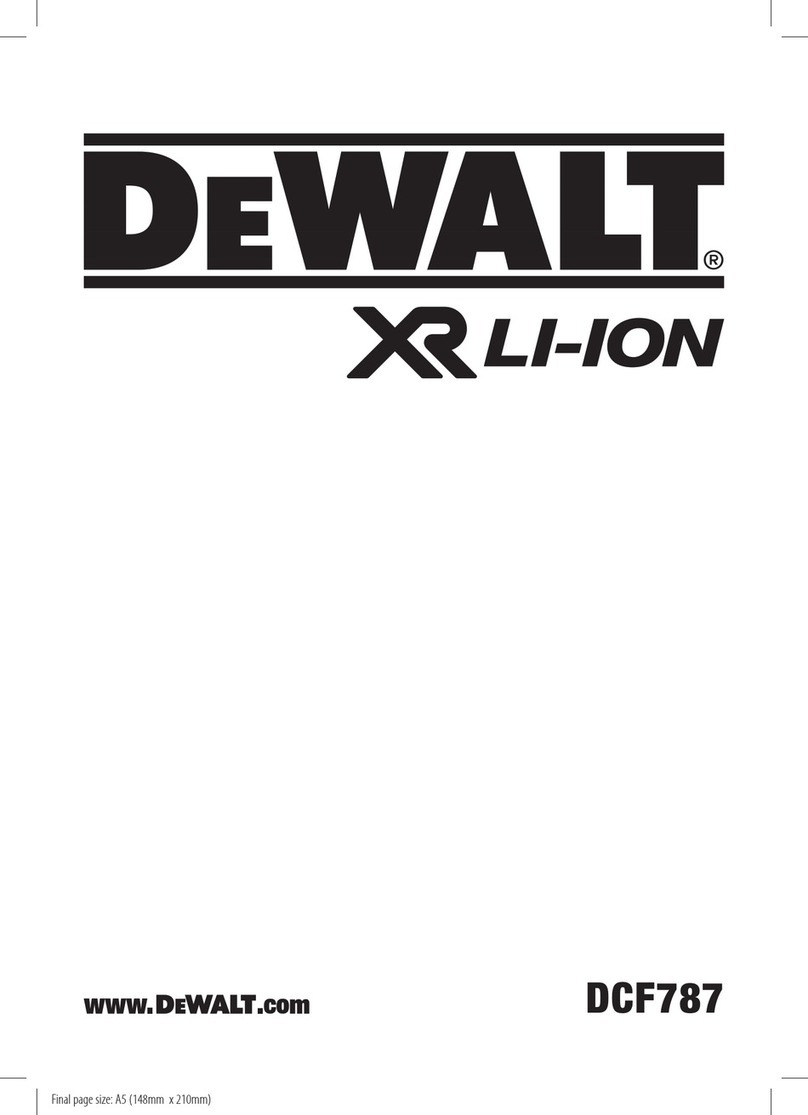
DeWalt
DeWalt DCF787N-XJ Original instructions

Makita
Makita DTD153RFJ instruction manual

Makita
Makita BTP130 instruction manual
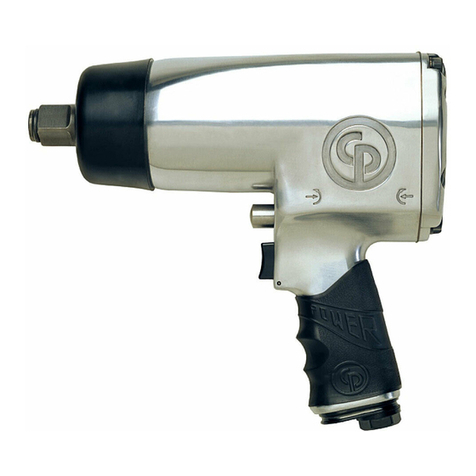
Chicago Pneumatic
Chicago Pneumatic CP772H Series Operator's manual
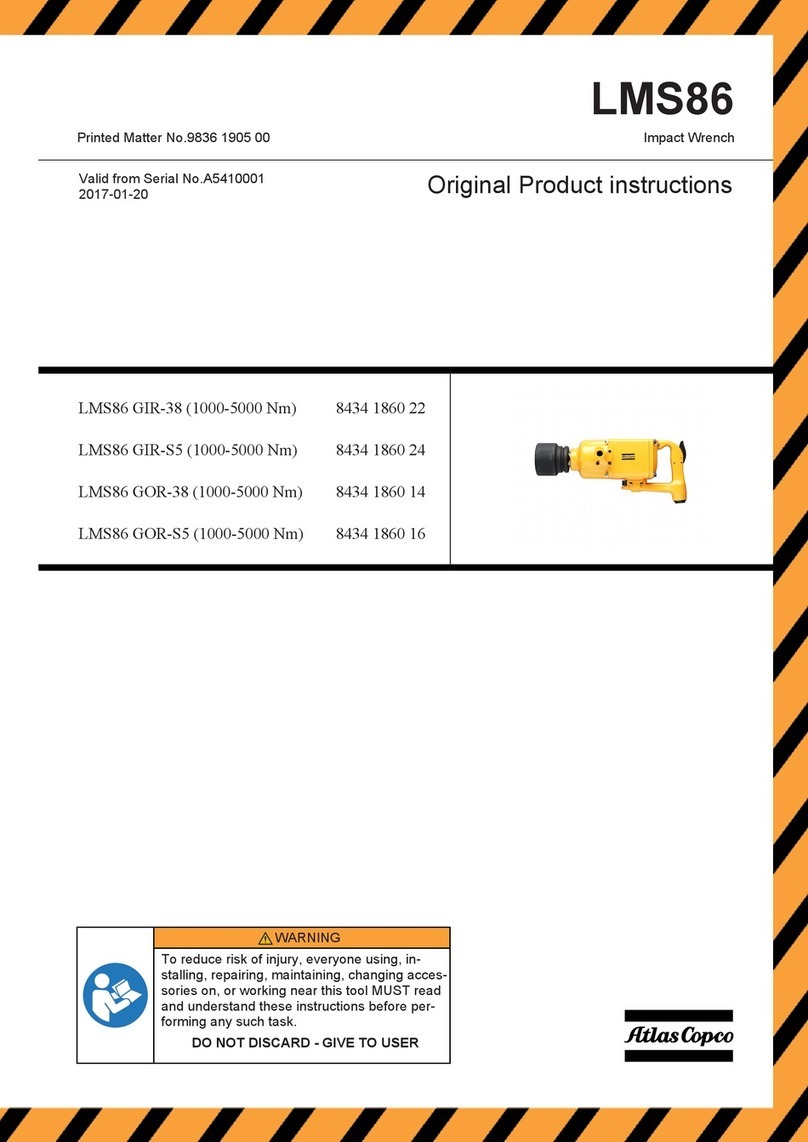
Atlas Copco
Atlas Copco LMS86 Original product instructions
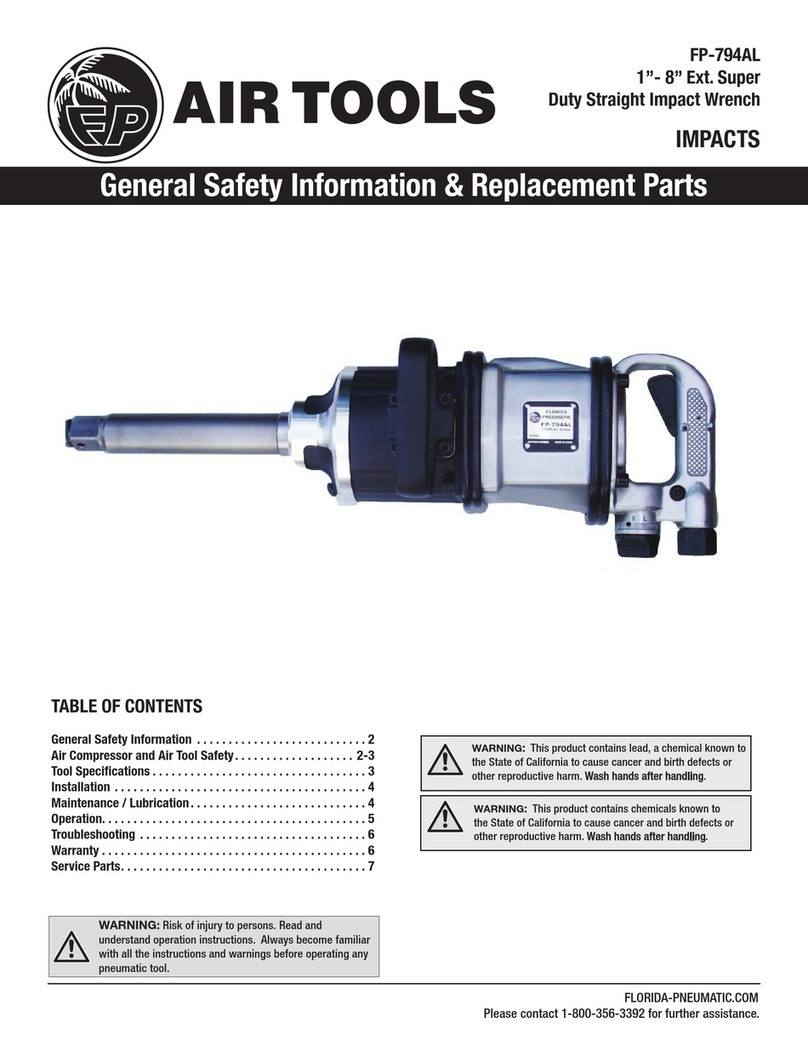
FP
FP 794AL General Safety Information & Replacement Parts
